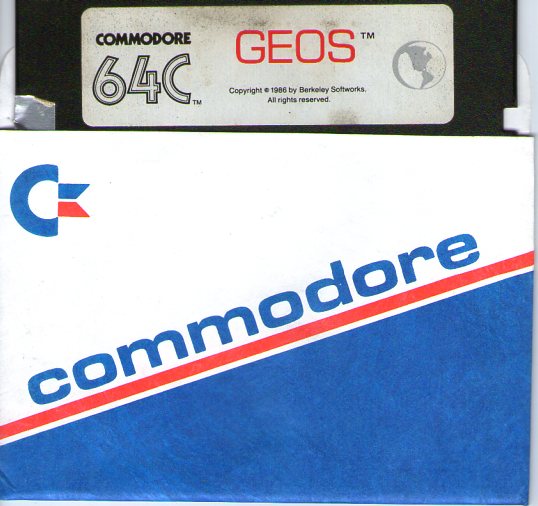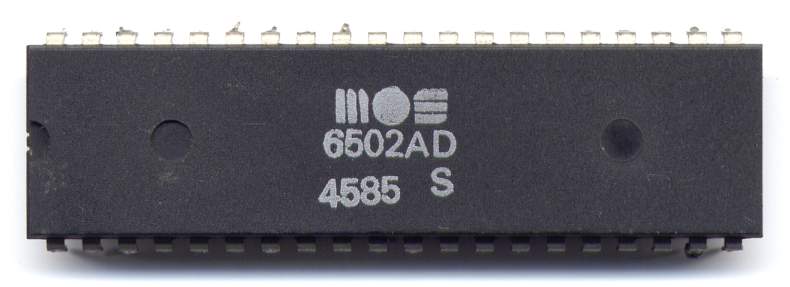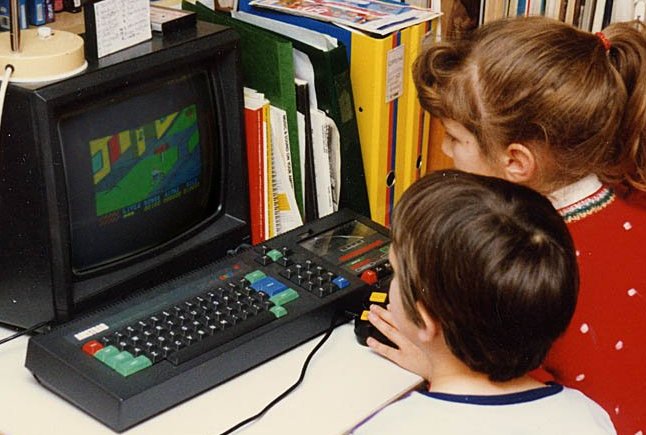|
Commodore 128
The Commodore 128, also known as the C128, is the last 8-bit home computer that was commercially released by Commodore Business Machines (CBM). Introduced in January 1985 at the CES in Las Vegas, it appeared three years after its predecessor, the Commodore 64, the bestselling computer of the 1980s. Approximately 2.5 million C128s were sold during its four-year production run. The C128 is a significantly expanded successor to the C64, with nearly full compatibility. It is housed in a redesigned case with an improved keyboard including a numeric keypad and function keys. Memory was enlarged to 128 KB of RAM in two 64 KB banks. A separate graphics chip provided 80-column color video output in addition to the original C64 modes. It also included a Zilog Z80 CPU which allows the C128 to run CP/M, as an alternative to the usual Commodore BASIC environment. The huge CP/M software library, coupled with the C64's software library, gave the C128 one of the broadest ranges ... [...More Info...] [...Related Items...] OR: [Wikipedia] [Google] [Baidu] |
CP/M
CP/M, originally standing for Control Program/Monitor and later Control Program for Microcomputers, is a mass-market operating system created in 1974 for Intel 8080/Intel 8085, 85-based microcomputers by Gary Kildall of Digital Research, Digital Research, Inc. CP/M is a disk operating system and its purpose is to organize files on a magnetic storage medium, and to load and run programs stored on a disk. Initially confined to single-tasking on 8-bit processors and no more than 64 kilobytes of memory, later versions of CP/M added multi-user variations and were migrated to 16-bit processors. CP/M's core components are the ''Basic Input/Output System'' (BIOS), the ''Basic Disk Operating System'' (BDOS), and the ''Console Command Processor'' (CCP). The BIOS consists of drivers that deal with devices and system hardware. The BDOS implements the file system and provides system services to applications. The CCP is the command-line interpreter and provides some built-in commands. CP ... [...More Info...] [...Related Items...] OR: [Wikipedia] [Google] [Baidu] |
Commodore BASIC
Commodore BASIC, also known as PET BASIC or CBM-BASIC, is the Dialect (computing), dialect of the BASIC programming language used in Commodore International's 8-bit home computer line, stretching from the Commodore PET, PET (1977) to the Commodore 128 (1985). The core is based on MOS Technology 6502, 6502 Microsoft BASIC, and as such it shares many characteristics with other 6502 BASICs of the time, such as Applesoft BASIC. Commodore licensed BASIC from Microsoft in 1977 on a "pay once, no royalties" basis after Jack Tramiel turned down Bill Gates' offer of a per unit fee, stating, "I'm already married," and would pay no more than for a perpetual license. The original Commodore PET, PET version was very similar to the original Microsoft implementation with few modifications. BASIC 2.0 on the Commodore 64, C64 was also similar, and was also seen on Commodore 128, C128s (in C64 mode) and other models. Later PETs featured BASIC 4.0, similar to the original but adding a number of co ... [...More Info...] [...Related Items...] OR: [Wikipedia] [Google] [Baidu] |
MOS Technology 8563
The 8563 Video Display Controller (VDC) was an integrated circuit produced by MOS Technology. It was used in the Commodore 128 (C128) computer to generate an 80-column (640 × 200 pixel) RGB video display, running alongside a VIC-II which supported Commodore 64-compatible graphics. The DCR models (as well as a few D-models) of the C128 used the later and more technically advanced 8568 DC controller. History and characteristics Originally intended for a planned (but unreleased) UNIX-based business computer based around the Zilog Z8000, Commodore designed the VDC into several prototype machines. Of these, only the Commodore 128 ever saw production. Unlike earlier MOS video chips such as the popular VIC-II, the VDC had dedicated video memory, 16 kilobytes (16,384 bytes; upgradable to 64 kilobytes, 65,536 bytes) in the original or "flat" C128 and 64 kilobytes in the C128DCR. This RAM was not directly accessible by the microprocessor. The 8563 was more difficult to produc ... [...More Info...] [...Related Items...] OR: [Wikipedia] [Google] [Baidu] |
MOS Technology 8502
The MOS Technology 8502 is an 8-bit microprocessor designed by MOS Technology and used in the Commodore 128 (C128). It is an improved version of the MOS 6510 used in the Commodore 64 (C64). It was manufactured using the HMOS process, allowing it to have higher transistor density, and lower cost, while dissipating less heat. The 8502 allows the C128 to run at double the clock rate of the C64 with some limitations. Description Memory access in 8-bit machines Common random-access memory (RAM) of the Commodore C64-era allowed accesses at 2 MHz. If the CPU and display chip both shared the same memory to communicate, which was the common solution in the era when RAM was expensive, then one would normally have to have the CPU and display chip arbitrate access to the bus so that only one of them used it at a time, generally by having one of them pause the other. Assuming the two chips require roughly equal access, that means the chips are paused half of the time, each effectively ... [...More Info...] [...Related Items...] OR: [Wikipedia] [Google] [Baidu] |
Commodore 64
The Commodore 64, also known as the C64, is an 8-bit computing, 8-bit home computer introduced in January 1982 by Commodore International (first shown at the Consumer Electronics Show, January 7–10, 1982, in Las Vegas). It has been listed in the Guinness World Records as the highest-selling single computer model of all time, with independent estimates placing the number sold between 12.5 and 17 million units. Volume production started in early 1982, marketing in August for . Preceded by the VIC-20 and Commodore PET, the C64 took its name from its of RAM. With support for multicolor sprite (computer graphics), sprites and a custom chip for waveform generation, the C64 could create superior visuals and audio compared to systems without such custom hardware. The C64 dominated the low-end computer market (except in the UK, France and Japan, lasting only about six months in Japan) for most of the later years of the 1980s. For a substantial period (1983–1986), the C64 had betwe ... [...More Info...] [...Related Items...] OR: [Wikipedia] [Google] [Baidu] |
MOS Technology VIC-II
The VIC-II (Video Interface Chip II), specifically known as the MOS Technology 6567/6566/8562/8564 (NTSC versions), 6569/8565/8566 (PAL), is the microchip tasked with generating Y/C video signals (combined to composite video in the RF modulator) and DRAM refresh signals in the Commodore 64 and Commodore 128 home computers. Succeeding the original MOS Technology VIC used in the VIC-20, the VIC-II was one of the key custom chips in the Commodore 64 (the other being the MOS Technology 6581 sound chip). Development history The VIC-II chip was designed primarily by Albert Charpentier and Charles Winterble at MOS Technology, Inc. as a successor to the MOS Technology 6560 "VIC". The team at MOS Technology had previously failed to produce two graphics chips named ''MOS Technology 6562'' for the Commodore TOI computer, and ''MOS Technology 6564'' for the Color PET, due to memory speed constraints. In order to construct the VIC-II, Charpentier and Winterble made a market survey of ... [...More Info...] [...Related Items...] OR: [Wikipedia] [Google] [Baidu] |
Commodore International
Commodore International Corporation was a home computer and electronics manufacturer with its head office in The Bahamas and its executive office in the United States founded in 1976 by Jack Tramiel and Irving Gould. It was the successor company to Commodore Business Machines (Canada) Ltd., established in 1958 by Tramiel and Manfred Kapp. Commodore International (CI), along with its U.S. subsidiary Commodore Business Machines, Inc. (CBM), was a significant participant in the development of the home computer industry, and at one point in the 1980s was the world's largest in the industry. The company released its first home computer, the Commodore PET, in 1977; it was followed by the VIC-20, the first ever computer to reach one million units of sales. In 1982, the company developed and marketed the world's best selling computer, the Commodore 64; its success made Commodore one of the world's largest personal computer manufacturers, with sales peaking in the last quarter of 1983 at ... [...More Info...] [...Related Items...] OR: [Wikipedia] [Google] [Baidu] |
GEOS (8-bit Operating System)
GEOS (''Graphic Environment Operating System'') is a discontinued operating system from Berkeley Softworks (later GeoWorks). Originally designed for the Commodore 64 with its version being released in 1986, enhanced versions of GEOS later became available in 1987 for the Commodore 128 and in 1988 for the Apple II. A lesser-known version was also released for the Commodore Plus/4. GEOS closely resembles early versions of the classic Mac OS and includes a graphical word processor (geoWrite) and Computer graphics, paint program (geoPaint). A December 1987 survey by the Commodore-dedicated magazine '' Compute!'s Gazette'' found that nearly half of respondents used GEOS. For many years, Commodore bundled GEOS with its redesigned and cost-reduced C64, the C64C. At its peak, GEOS was the third-most-popular microcomputer operating system in the world in terms of units shipped, trailing only MS-DOS and Mac OS (besides the original Commodore 64's KERNAL). Other GEOS-compatible softwar ... [...More Info...] [...Related Items...] OR: [Wikipedia] [Google] [Baidu] |
8-bit
In computer architecture, 8-bit integers or other data units are those that are 8 bits wide (1 octet). Also, 8-bit central processing unit (CPU) and arithmetic logic unit (ALU) architectures are those that are based on registers or data buses of that size. Memory addresses (and thus address buses) for 8-bit CPUs are generally larger than 8-bit, usually 16-bit. 8-bit microcomputers are microcomputers that use 8-bit microprocessors. The term '8-bit' is also applied to the character sets that could be used on computers with 8-bit bytes, the best known being various forms of extended ASCII, including the ISO/IEC 8859 series of national character sets especially Latin 1 for English and Western European languages. The IBM System/360 introduced byte-addressable memory with 8-bit bytes, as opposed to bit-addressable or decimal digit-addressable or word-addressable memory, although its general-purpose registers were 32 bits wide, and addresses were contained in the lower 24 bits ... [...More Info...] [...Related Items...] OR: [Wikipedia] [Google] [Baidu] |
Home Computer
Home computers were a class of microcomputers that entered the market in 1977 and became common during the 1980s. They were marketed to consumers as affordable and accessible computers that, for the first time, were intended for the use of a single, non-technical user. These computers were a distinct market segment that typically cost much less than business, scientific, or engineering-oriented computers of the time, such as those running CP/M or the IBM PC, and were generally less powerful in terms of computer memory, memory and expandability. However, a home computer often had better video display controller, graphics and sound than contemporary business computers. Their most common uses were word processing, playing video games, and computer programming, programming. Home computers were usually sold already manufactured in stylish metal or plastic enclosures. However, some home computers also came as commercial electronic kits, like the ZX80, Sinclair ZX80, which were both h ... [...More Info...] [...Related Items...] OR: [Wikipedia] [Google] [Baidu] |
Consumer Electronics Show
CES (; formerly an initialism for Consumer Electronics Show) is an annual trade show organized by the Consumer Technology Association (CTA). Held in January at the Las Vegas Convention Center in Winchester, Nevada, United States, the event typically hosts presentations of new products and technologies in the consumer electronics industry. History The first CES was held in June 1967 in New York City. It was a spin-off of the Chicago Music Show which, until then, had served as the main event for exhibiting consumer electronics. The event had 17,500 attendees and over 100 exhibitors; the kickoff speaker was Motorola chairman Bob Galvin. From 1978 to 1994, CES was held twice each year: once in January in Las Vegas as the ''Winter Consumer Electronics Show'' (WCES) and once in June in Chicago as the ''Summer Consumer Electronics Show'' (SCES). The winter show was held in Las Vegas in 1995 as planned. However, since the summer Chicago shows were beginning to lose popularity, the ... [...More Info...] [...Related Items...] OR: [Wikipedia] [Google] [Baidu] |



